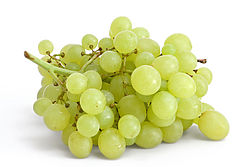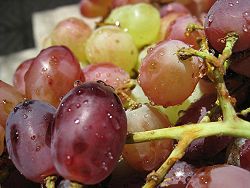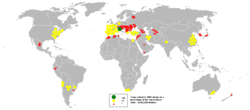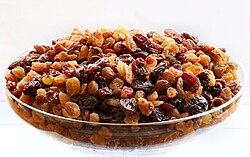Grape: Difference between revisions
Shadowjams (talk | contribs) m Reverted edits by 76.233.173.27 to last revision by 128.208.61.81 (HG) |
m Undoing residual vandalism from edit of 17:09, 25 February 2010 |
||
| Line 2: | Line 2: | ||
[[File:Table grapes on white.jpg|thumb|250px|"White" table grapes]] |
[[File:Table grapes on white.jpg|thumb|250px|"White" table grapes]] |
||
{{Nutritional value |
{{Nutritional value |
||
| name= |
| name=Grapes, purple or green |
||
| kJ=288 |
| kJ=288 |
||
| protein=0.72 g |
| protein=0.72 g |
||
Revision as of 18:13, 13 March 2010

| Nutritional value per 100 g (3.5 oz) | |
|---|---|
| Energy | 288 kJ (69 kcal) |
18.1 g | |
| Sugars | 15.48 g |
| Dietary fiber | 0.9 g |
0.16 g | |
0.72 g | |
| Vitamins | Quantity %DV† |
| Thiamine (B1) | 6% 0.069 mg |
| Riboflavin (B2) | 5% 0.07 mg |
| Niacin (B3) | 1% 0.188 mg |
| Pantothenic acid (B5) | 1% 0.05 mg |
| Vitamin B6 | 5% 0.086 mg |
| Folate (B9) | 1% 2 μg |
| Vitamin B12 | 0% 0 μg |
| Vitamin C | 12% 10.8 mg |
| Vitamin K | 18% 22 μg |
| Minerals | Quantity %DV† |
| Calcium | 1% 10 mg |
| Iron | 2% 0.36 mg |
| Magnesium | 2% 7 mg |
| Manganese | 3% 0.071 mg |
| Phosphorus | 2% 20 mg |
| Potassium | 6% 191 mg |
| Sodium | 0% 3.02 mg |
| Zinc | 1% 0.07 mg |
| †Percentages estimated using US recommendations for adults,[1] except for potassium, which is estimated based on expert recommendation from the National Academies.[2] | |
A grape is the non-climacteric fruit, botanically a true berry, that grows on the perennial and deciduous woody vines of the genus Vitis. Grapes can be eaten raw or used for making jam, juice, jelly, vinegar, drugs, wine, grape seed extracts, raisins, and grape seed oil. Grapes are also used in some kinds of confectionery. A grape is sometimes used as the symbol of conscience.
History
The domestication of purple grapes originated in what is now southern Turkey. Yeast, one of the earliest domesticated microorganisms, occurs naturally on the skins of grapes, leading to the innovation of alcoholic drinks such as wine. Ancient Egyptian hieroglyphics record the cultivation of purple grapes, and history attests to the ancient Greeks, Phoenicians and Romans growing purple grapes for both eating and wine production. Later, the growing of grapes spread to Europe, North Africa, and eventually North America.
Native purple grapes belonging to the vitis genus proliferated in the wild across North America, and were a part of the diet of many North American first peoples, but were considered by European colonists to be unsuitable for wine. The first Old World vitis vinifera purple grapes were cultivated in California where Spain had established a series of monasteries along the coasts to supply their navies with oranges to prevent scurvy and convert natives.
Description
Grapes grow in clusters of 6 to 300, and can be crimson, black, dark blue, yellow, green and pink. "White" grapes are actually green in color, and are evolutionarily derived from the purple grape. Mutations in two regulatory genes of white grapes turn off production of anthocyanins which are responsible for the color of purple grapes.[3] Anthocyanins and other pigment chemicals of the larger family of polyphenols in purple grapes are responsible for the varying shades of purple in red wines.[4][5]
Grapevines

Most grapes come from cultivars of Vitis vinifera, the European grapevine native to the Mediterranean and Central Asia. Minor amounts of fruit and wine come from American and Asian species such as:
- Vitis labrusca, the North American table and grape juice grapevines (including the concord cultivar), sometimes used for wine. Native to the Eastern United States and Canada.
- Vitis riparia, a wild vine of North America, sometimes used for winemaking and for jam. Native to the entire Eastern U.S. and north to Quebec.
- Vitis rotundifolia, the muscadines, used for jams and wine. Native to the Southeastern United States from Delaware to the Gulf of Mexico.
- Vitis amurensis, the most important Asian species.
Distribution and production

According to the Food and Agriculture Organization (FAO), 75,866 square kilometres of the world are dedicated to grapes. Approximately 71% of world grape production is used for wine, 27% as fresh fruit, and 2% as dried fruit. A portion of grape production goes to producing grape juice to be reconstituted for fruits canned "with no added sugar" and "100% natural". The area dedicated to vineyards is increasing by about 2% per year.
The following table of top wine-producers shows the corresponding areas dedicated to grapes for wine making:
| Country | Area dedicated |
|---|---|
| Spain | 11,750 km² |
| France | 8,640 km² |
| Italy | 8,270 km² |
| Turkey | 8,120 km² |
| United States | 4,150 km² |
| Iran | 2,860 km² |
| Romania | 2,480 km² |
| Portugal | 2,160 km² |
| Argentina | 2,080 km² |
| Australia | 1,642 km² |
| Lebanon | 1,122 km² |
| Top Ten Grapes Producers — 08 October 2009 | ||||
|---|---|---|---|---|
| Country | Production (Tonnes) | Footnote | ||
| 8,519,418 | F | |||
| 6,787,081 | F | |||
| 6,384,090 | F | |||
| 6,044,900 | F | |||
| 5,995,300 | F | |||
| 3,612,781 | F | |||
| 3,000,000 | F | |||
| 2,900,000 | F | |||
| 2,350,000 | F | |||
| 1,667,700 | F | |||
| World | 67,221,000 | A | ||
| No symbol = official figure, P = official figure, F = FAOSTAT 2007, * = Unofficial/Semi-official/mirror data, C = Calculated figure A = Aggregate (may include official, semi-official or estimates); | ||||
Table and wine grapes
Commercially cultivated grapes can usually be classified as either table or wine grapes, based on their intended method of consumption: eaten raw (table grapes) or used to make wine (wine grapes). While almost all of them belong to the same species, vitis vinifera, table and wine grapes have significant differences, brought about through selective breeding. Table grape cultivars tend to have large, seedless fruit (see below) with relatively thin skin. Wine grapes are smaller, usually seeded, and have relatively thick skins (a desirable characteristic in winemaking, since much of the aroma in wine comes from the skin). Wine grapes also tend to be very sweet: the are harvested at the time when their juice is approximately 24% sugar by weight. By comparison, commercially-produced "100% grape juice", made from table grapes, is usually around 15% sugar by weight.[6]
Seedless grapes
Seedlessness is a highly desirable subjective quality in table grape selection, and seedless cultivars now make up the overwhelming majority of table grape plantings. Because grapevines are vegetatively propagated by cuttings, the lack of seeds does not present a problem for reproduction. It is, however, an issue for breeders, who must either use a seeded variety as the female parent or rescue embryos early in development using tissue culture techniques.
There are several sources of the seedlessness trait, and essentially all commercial cultivators get it from one of three sources: Thompson Seedless, Russian Seedless, and Black Monukka, all being cultivars of Vitis vinifera. There are currently more than a dozen varieties of seedless grapes. Several, such as Einset Seedless, Reliance and Venus, have been specifically cultivated for hardiness and quality in the relatively cold climates of north-eastern United States and southern Ontario.[7]
An offset to the improved eating quality of seedlessness is the loss of potential health benefits provided by the enriched phytochemical content of grape seeds (see Health claims, below).[8][9]
Raisins, currants and sultanas

In most of Europe, dried grapes are referred to as 'raisins' or the local equivalent. In the UK, three different varieties are recognized, forcing the EU to use the term "Dried vine fruit" in official documents.
A raisin is any dried grape. While raisin is a French loanword, the word in French refers to the fresh fruit; grappe (from which the English grape is derived) refers to the bunch (as in une grappe de raisins).
A currant is a dried Zante Black Corinth grape, the name being a corruption of the French raisin de Corinthe (Corinth grape). Currant has also come to refer to the blackcurrant and redcurrant, two berries unrelated to grapes.
A sultana was originally a raisin made from a specific type of grape of Turkish origin, but the word is now applied to raisins made from common grapes and chemically treated to resemble the traditional sultana.
Health claims
French Paradox
Comparing diets among Western countries, researchers have discovered that although the French tend to eat higher levels of animal fat, surprisingly the incidence of heart disease remains low in France, a phenomenon named the French Paradox and thought to occur from protective benefits of regularly consuming red wine. Apart from potential benefits of alcohol itself, including reduced platelet aggregation and vasodilation,[10] polyphenols (e.g., resveratrol) mainly in the grape skin provide other suspected health benefits, such as:[11]
- alteration of molecular mechanisms in blood vessels, reducing susceptibility to vascular damage
- decreased activity of angiotensin, a systemic hormone causing blood vessel constriction that would elevate blood pressure
- increased production of the vasodilator hormone, nitric oxide (endothelium-derived relaxing factor)
Although adoption of wine consumption is not recommended by some health authorities,[12] a significant volume of research indicates moderate consumption, such as one glass of red wine a day for women and two for men, may confer health benefits.[13][14][15] Emerging evidence is that wine polyphenols like resveratrol[16] provide physiological benefit whereas alcohol itself may have protective effects on the cardiovascular system.[17]
Resveratrol
Grape phytochemicals such as resveratrol (a polyphenol antioxidant), have been positively linked to inhibiting any cancer, heart disease, degenerative nerve disease, viral infections and mechanisms of Alzheimer's disease.[18][19]
Protection of the genome through antioxidant actions may be a general function of resveratrol.[20] In laboratory studies, resveratrol bears a significant transcriptional overlap with the beneficial effects of calorie restriction in heart, skeletal muscle and brain. Both dietary interventions inhibit gene expression associated with heart and skeletal muscle aging, and prevent age-related heart failure.[21]
Resveratrol is the subject of several human clinical trials,[22] among which the most advanced is a one year dietary regimen in a Phase III study of elderly patients with Alzheimer's disease.[23]
Synthesized by many plants, resveratrol apparently serves antifungal and other defensive properties. Dietary resveratrol has been shown to modulate the metabolism of lipids and to inhibit oxidation of low-density lipoproteins and aggregation of platelets.[24]
Resveratrol is found in wide amounts among grape varieties, primarily in their skins and seeds which, in muscadine grapes, have about one hundred times higher concentration than pulp.[25] Fresh grape skin contains about 50 to 100 micrograms of resveratrol per gram.[26]
Anthocyanins and other phenolics

Anthocyanins tend to be the main polyphenolics in purple grapes whereas flavan-3-ols (e.g., catechins) are the more abundant phenolic in white varieties.[27] Total phenolic content, an index of dietary antioxidant strength, is higher in purple varieties due almost entirely to anthocyanin density in purple grape skin compared to absence of anthocyanins in white grape skin.[27] It is these anthocyanins that are attracting the efforts of scientists to define their properties for human health.[28] Phenolic content of grape skin varies with cultivar, soil composition, climate, geographic origin, and cultivation practices or exposure to diseases, such as fungal infections.
Red wine offers health benefits more so than white because many beneficial compounds are present in grape skin, and only red wine is fermented with skins. The amount of fermentation time a wine spends in contact with grape skins is an important determinant of its resveratrol content.[6] Ordinary non-muscadine red wine contains between 0.2 and 5.8 mg/L,[29] depending on the grape variety, because it is fermented with the skins, allowing the wine to absorb the resveratrol. By contrast, a white wine contains lower phenolic contents because it is fermented after removal of skins.
Wines produced from muscadine grapes may contain more than 40 mg/L, an exceptional phenolic content.[25][30] In muscadine skins, ellagic acid, myricetin, quercetin, kaempferol, and trans-resveratrol are major phenolics.[31] Contrary to previous results, ellagic acid and not resveratrol is the major phenolic in muscadine grapes.
The flavonols syringetin, syringetin 3-O-galactoside, laricitrin and laricitrin 3-O-galactoside are also found in purple grape but absent in white grape[32].
Seed constituents
Since the 1980s, biochemical and medical studies have demonstrated significant antioxidant properties of grape seed oligomeric proanthocyanidins.[33] Together with tannins, polyphenols and polyunsaturated fatty acids, these seed constituents display inhibitory activities against several experimental disease models, including cancer, heart failure and other disorders of oxidative stress.[34][35]
Grape seed oil from crushed seeds is used in cosmeceuticals and skincare products for many perceived health benefits. Grape seed oil is notable for its high contents of tocopherols (vitamin E), phytosterols, and polyunsaturated fatty acids such as linoleic acid, oleic acid and alpha-linolenic acid.[36][37][38]
Concord grape juice
Commercial juice products from Concord grapes have been applied in medical research studies, showing potential benefits against the onset stage of cancer,[39] platelet aggregation and other risk factors of atherosclerosis,[40] loss of physical performance and mental acuity during aging[41] and hypertension in humans.[42]
See also
Sources
- Footnotes
- ^ United States Food and Drug Administration (2024). "Daily Value on the Nutrition and Supplement Facts Labels". FDA. Archived from the original on 2024-03-27. Retrieved 2024-03-28.
- ^ National Academies of Sciences, Engineering, and Medicine; Health and Medicine Division; Food and Nutrition Board; Committee to Review the Dietary Reference Intakes for Sodium and Potassium (2019). Oria, Maria; Harrison, Meghan; Stallings, Virginia A. (eds.). Dietary Reference Intakes for Sodium and Potassium. The National Academies Collection: Reports funded by National Institutes of Health. Washington, DC: National Academies Press (US). ISBN 978-0-309-48834-1. PMID 30844154. Archived from the original on 2024-05-09. Retrieved 2024-06-21.
- ^ Walker AR, Lee E, Bogs J, McDavid DA, Thomas MR, Robinson SP, AR (2007). "White grapes arose through the mutation of two similar and adjacent regulatory genes". Plant J. 49 (5): 772–85. doi:10.1111/j.1365-313X.2006.02997.x+. ISSN 0960-7412. PMID 17316172.
{{cite journal}}:|first2=missing|last2=(help);|first3=missing|last3=(help);|first4=missing|last4=(help);|first5=missing|last5=(help);|first6=missing|last6=(help); Unknown parameter|doi_brokendate=ignored (|doi-broken-date=suggested) (help); Unknown parameter|month=ignored (help)CS1 maint: multiple names: authors list (link) - ^ Waterhouse AL, AL (2002). "Wine phenolics". Ann. N. Y. Acad. Sci. 957: 21–36. doi:10.1111/j.1749-6632.2002.tb02903.x. ISSN 0077-8923. PMID 12074959.
{{cite journal}}: Unknown parameter|month=ignored (help) - ^ Brouillard R, Chassaing S, Fougerousse A, R (2003). "Why are grape/fresh wine anthocyanins so simple and why is it that red wine color lasts so long?". Phytochemistry. 64 (7): 1179–86. doi:10.1016/S0031-9422(03)00518-1. ISSN 0031-9422. PMID 14599515.
{{cite journal}}:|first2=missing|last2=(help);|first3=missing|last3=(help); Unknown parameter|month=ignored (help)CS1 maint: multiple names: authors list (link) - ^ "Wine Grapes and Grape-y Wines". Retrieved 03/07/2010.
{{cite web}}: Check date values in:|accessdate=(help) - ^ Reisch BI, Peterson DV, Martens M-H. "Seedless Grapes", in "Table Grape Varieties for Cool Climates", Information Bulletin 234, Cornell University, New York State Agricultural Experiment Station, retrieved December 30, 2008
- ^ Shi J, Yu J, Pohorly JE, Kakuda Y, J (2003). "Polyphenolics in grape seeds-biochemistry and functionality". J Med Food. 6 (4): 291–9. doi:10.1089/109662003772519831. ISSN 1096-620X. PMID 14977436.
{{cite journal}}:|first2=missing|last2=(help);|first3=missing|last3=(help);|first4=missing|last4=(help); Unknown parameter|month=ignored (help)CS1 maint: multiple names: authors list (link) - ^ Parry J, Su L, Moore J, J; et al. (2006). "Chemical compositions, antioxidant capacities, and antiproliferative activities of selected fruit seed flours". J. Agric. Food Chem. 54 (11): 3773–8. doi:10.1021/jf060325k. ISSN 0021-8561. PMID 16719495.
{{cite journal}}:|first2=missing|last2=(help);|first3=missing|last3=(help);|first4=missing|last4=(help);|first5=missing|last5=(help);|first6=missing|last6=(help);|first7=missing|last7=(help);|first8=missing|last8=(help); Explicit use of et al. in:|author=(help); Unknown parameter|month=ignored (help)CS1 maint: multiple names: authors list (link) - ^ Providência R, R (2006). "Cardiovascular protection from alcoholic drinks: scientific basis of the French Paradox" (Free full text). Rev Port Cardiol. 25 (11): 1043–58. ISSN 0870-2551. PMID 17274460.
{{cite journal}}: Unknown parameter|month=ignored (help) - ^ Opie LH, Lecour S, LH (2007). "The red wine hypothesis: from concepts to protective signalling molecules" (Free full text). Eur. Heart J. 28 (14): 1683–93. doi:10.1093/eurheartj/ehm149. ISSN 0195-668X. PMID 17561496.
{{cite journal}}:|first2=missing|last2=(help); Unknown parameter|month=ignored (help) - ^ American Heart Association, Alcohol, wine and cardiovascular disease.[1]
- ^ Alcohol. Harvard School of Public Health
- ^ Mukamal KJ, Kennedy M, Cushman M, KJ; et al. (2008). "Alcohol consumption and lower extremity arterial disease among older adults: the cardiovascular health study" (Free full text). Am. J. Epidemiol. 167 (1): 34–41. doi:10.1093/aje/kwm274. ISSN 0002-9262. PMID 17971339.
{{cite journal}}:|first2=missing|last2=(help);|first3=missing|last3=(help);|first4=missing|last4=(help);|first5=missing|last5=(help);|first6=missing|last6=(help);|first7=missing|last7=(help);|first8=missing|last8=(help); Explicit use of et al. in:|author=(help); Unknown parameter|month=ignored (help)CS1 maint: multiple names: authors list (link) - ^ de Lange DW, van de Wiel A, DW (2004). "Drink to prevent: review on the cardioprotective mechanisms of alcohol and red wine polyphenols". Semin Vasc Med. 4 (2): 173–86. doi:10.1055/s-2004-835376. ISSN 1528-9648. PMID 15478039.
{{cite journal}}:|first2=missing|last2=(help); Unknown parameter|month=ignored (help) - ^ Das S, Das DK, S (2007). "Resveratrol: a therapeutic promise for cardiovascular diseases". Recent Patents Cardiovasc Drug Discov. 2 (2): 133–8. doi:10.2174/157489007780832560. ISSN 1574-8901. PMID 18221111.
{{cite journal}}:|first2=missing|last2=(help); Unknown parameter|month=ignored (help) - ^ Sato M, Maulik N, Das DK, M (2002). "Cardioprotection with alcohol: role of both alcohol and polyphenolic antioxidants". Ann. N. Y. Acad. Sci. 957: 122–35. doi:10.1111/j.1749-6632.2002.tb02911.x. ISSN 0077-8923. PMID 12074967.
{{cite journal}}:|first2=missing|last2=(help);|first3=missing|last3=(help); Unknown parameter|month=ignored (help)CS1 maint: multiple names: authors list (link) - ^ Shankar S, Singh G, Srivastava RK, S (2007). "Chemoprevention by resveratrol: molecular mechanisms and therapeutic potential". Front. Biosci. 12: 4839–54. doi:10.2741/2432. ISSN 1093-9946. PMID 17569614.
{{cite journal}}:|first2=missing|last2=(help);|first3=missing|last3=(help); Unknown parameter|month=ignored (help)CS1 maint: multiple names: authors list (link) - ^ Mancuso C, Bates TE, Butterfield DA, C; et al. (2007). "Natural antioxidants in Alzheimer's disease". Expert Opin Investig Drugs. 16 (12): 1921–31. doi:10.1517/13543784.16.12.1921. ISSN 1354-3784. PMID 18042001.
{{cite journal}}:|first2=missing|last2=(help);|first3=missing|last3=(help);|first4=missing|last4=(help);|first5=missing|last5=(help);|first6=missing|last6=(help);|first7=missing|last7=(help);|first8=missing|last8=(help); Explicit use of et al. in:|author=(help); Unknown parameter|month=ignored (help)CS1 maint: multiple names: authors list (link) - ^ Gatz SA, Wiesmüller L, SA (2008). "Take a break—resveratrol in action on DNA" (Free full text). Carcinogenesis. 29 (2): 321–32. doi:10.1093/carcin/bgm276. ISSN 0143-3334. PMID 18174251.
{{cite journal}}:|first2=missing|last2=(help); Unknown parameter|month=ignored (help) - ^ Barger JL, Kayo T, Vann JM, JL; Saupe, KW; Cartee, GD; Weindruch, R; Prolla, TA; et al. (2008). "A low dose of dietary resveratrol partially mimics caloric restriction and retards aging parameters in mice" (Free full text). PLoS ONE. 3 (6): e2264. doi:10.1371/journal.pone.0002264. PMC 2386967. PMID 18523577.
{{cite journal}}:|first10=missing|last10=(help);|first11=missing|last11=(help);|first2=missing|last2=(help);|first3=missing|last3=(help);|first4=missing|last4=(help);|first5=missing|last5=(help);|first6=missing|last6=(help);|first7=missing|last7=(help);|first8=missing|last8=(help);|first9=missing|last9=(help); Explicit use of et al. in:|author=(help); Unknown parameter|month=ignored (help)CS1 maint: multiple names: authors list (link) CS1 maint: unflagged free DOI (link) - ^ Listing of resveratrol clinical trials, ClinicalTrials.gov, a service of the US National Institutes of Health [2]
- ^ Randomized Trial of a Nutritional Supplement in Alzheimer's Disease, US Department of Veterans Affairs, Mount Sinai School of Medicine, May 2008 [3]
- ^ Chan WK, Delucchi AB, WK (2000). "Resveratrol, a red wine constituent, is a mechanism-based inactivator of cytochrome P450 3A4". Life Sci. 67 (25): 3103–12. doi:10.1016/S0024-3205(00)00888-2. ISSN 0024-3205. PMID 11125847.
{{cite journal}}:|first2=missing|last2=(help); Unknown parameter|month=ignored (help) - ^ a b LeBlanc, MR (2005). Cultivar, Juice Extraction, Ultra Violet Irradiation and Storage Influence the Stilbene Content of Muscadine Grapes (Vitis Rotundifolia Michx.). PhD Dissertation, Louisiana State University [4]
- ^ Li X, Wu B, Wang L, Li S, X (2006). "Extractable amounts of trans-resveratrol in seed and berry skin in Vitis evaluated at the germplasm level". J. Agric. Food Chem. 54 (23): 8804–11. doi:10.1021/jf061722y. ISSN 0021-8561. PMID 17090126.
{{cite journal}}:|first2=missing|last2=(help);|first3=missing|last3=(help);|first4=missing|last4=(help); Unknown parameter|month=ignored (help)CS1 maint: multiple names: authors list (link) - ^ a b Cantos E, Espín JC, Tomás-Barberán FA, E (2002). "Varietal differences among the polyphenol profiles of seven table grape cultivars studied by LC-DAD-MS-MS". J. Agric. Food Chem. 50 (20): 5691–6. doi:10.1021/jf0204102. ISSN 0021-8561. PMID 12236700.
{{cite journal}}:|first2=missing|last2=(help);|first3=missing|last3=(help); Unknown parameter|month=ignored (help)CS1 maint: multiple names: authors list (link) - ^ Journal of Agricultural and Food Chemistry Presents Research from the 2007 International Berry Health Benefits Symposium, Journal of Agricultural and Food Chemistry ACS Publications, February 2008
- ^ Gu X, Creasy L, Kester A, Zeece M, X (1999). "Capillary electrophoretic determination of resveratrol in wines". J. Agric. Food Chem. 47 (8): 3223–7. doi:10.1021/jf981211e. ISSN 0021-8561. PMID 10552635.
{{cite journal}}:|first2=missing|last2=(help);|first3=missing|last3=(help);|first4=missing|last4=(help); Unknown parameter|month=ignored (help)CS1 maint: multiple names: authors list (link) - ^ Ector BJ, Magee JB, Hegwood CP, Coign MJ. Resveratrol Concentration in Muscadine Berries, Juice, Pomace, Purees, Seeds, and Wines. [5]
- ^ Pastrana-Bonilla E, Akoh CC, Sellappan S, Krewer G, E (2003). "Phenolic content and antioxidant capacity of muscadine grapes". J. Agric. Food Chem. 51 (18): 5497–503. doi:10.1021/jf030113c. ISSN 0021-8561. PMID 12926904.
{{cite journal}}:|first2=missing|last2=(help);|first3=missing|last3=(help);|first4=missing|last4=(help); Unknown parameter|month=ignored (help)CS1 maint: multiple names: authors list (link) - ^ Metabolite Profiling of Grape: Flavonols and Anthocyanins. Fulvio Mattivi, Raffaele Guzzon, Urska Vrhovsek, Marco Stefanini and Riccardo Velasco, J. Agric. Food Chem., 2006, 54 (20), pp 7692–7702
- ^ Bagchi D, Bagchi M, Stohs SJ, D; et al. (2000). "Free radicals and grape seed proanthocyanidin extract: importance in human health and disease prevention". Toxicology. 148 (2–3): 187–97. doi:10.1016/S0300-483X(00)00210-9. ISSN 0300-483X. PMID 10962138.
{{cite journal}}:|first2=missing|last2=(help);|first3=missing|last3=(help);|first4=missing|last4=(help);|first5=missing|last5=(help);|first6=missing|last6=(help);|first7=missing|last7=(help);|first8=missing|last8=(help); Explicit use of et al. in:|author=(help); Unknown parameter|month=ignored (help)CS1 maint: multiple names: authors list (link) - ^ Agarwal C, Singh RP, Agarwal R, C (2002). "Grape seed extract induces apoptotic death of human prostate carcinoma DU145 cells via caspases activation accompanied by dissipation of mitochondrial membrane potential and cytochrome c release". Carcinogenesis. 23 (11): 1869–76. doi:10.1093/carcin/23.11.1869. ISSN 0143-3334. PMID 12419835.
{{cite journal}}:|first2=missing|last2=(help);|first3=missing|last3=(help); Unknown parameter|month=ignored (help)CS1 maint: multiple names: authors list (link) - ^ Bagchi D, Sen CK, Ray SD, D; et al. (2003). "Molecular mechanisms of cardioprotection by a novel grape seed proanthocyanidin extract". Mutat. Res. 523–524: 87–97. doi:10.1016/S0027-5107(02)00324-X. ISSN 0027-5107. PMID 12628506.
{{cite journal}}:|first2=missing|last2=(help);|first3=missing|last3=(help);|first4=missing|last4=(help);|first5=missing|last5=(help);|first6=missing|last6=(help);|first7=missing|last7=(help); Explicit use of et al. in:|author=(help); Unknown parameter|month=ignored (help)CS1 maint: multiple names: authors list (link) - ^ Beveridge TH, Girard B, Kopp T, Drover JC, TH (2005). "Yield and composition of grape seed oils extracted by supercritical carbon dioxide and petroleum ether: varietal effects". J. Agric. Food Chem. 53 (5): 1799–804. doi:10.1021/jf040295q. ISSN 0021-8561. PMID 15740076.
{{cite journal}}:|first2=missing|last2=(help);|first3=missing|last3=(help);|first4=missing|last4=(help); Unknown parameter|month=ignored (help)CS1 maint: multiple names: authors list (link) - ^ Crews C, Hough P, Godward J, C; et al. (2006). "Quantitation of the main constituents of some authentic grape-seed oils of different origin". J. Agric. Food Chem. 54 (17): 6261–5. doi:10.1021/jf060338y. ISSN 0021-8561. PMID 16910717.
{{cite journal}}:|first2=missing|last2=(help);|first3=missing|last3=(help);|first4=missing|last4=(help);|first5=missing|last5=(help);|first6=missing|last6=(help);|first7=missing|last7=(help); Explicit use of et al. in:|author=(help); Unknown parameter|month=ignored (help)CS1 maint: multiple names: authors list (link) - ^ Tangolar SG, Ozoğul Y, Tangolar S, Torun A, SG (2007). "Evaluation of fatty acid profiles and mineral content of grape seed oil of some grape genotypes". Int J Food Sci Nutr. 60: 1–8. doi:10.1080/09637480701581551. ISSN 0963-7486. PMID 17886077.
{{cite journal}}:|first2=missing|last2=(help);|first3=missing|last3=(help);|first4=missing|last4=(help); Unknown parameter|month=ignored (help)CS1 maint: multiple names: authors list (link) - ^ Jung KJ, Wallig MA, Singletary KW, KJ (2006). "Purple grape juice inhibits 7,12-dimethylbenz[a]anthracene (DMBA)-induced rat mammary tumorigenesis and in vivo DMBA-DNA adduct formation". Cancer Lett. 233 (2): 279–88. doi:10.1016/j.canlet.2005.03.020. ISSN 0304-3835. PMID 15878797.
{{cite journal}}:|first2=missing|last2=(help);|first3=missing|last3=(help); Unknown parameter|month=ignored (help)CS1 maint: multiple names: authors list (link) - ^ Shanmuganayagam D, Warner TF, Krueger CG, Reed JD, Folts JD, D (2007). "Concord grape juice attenuates platelet aggregation, serum cholesterol and development of atheroma in hypercholesterolemic rabbits". Atherosclerosis. 190 (1): 135–42. doi:10.1016/j.atherosclerosis.2006.03.017. ISSN 0021-9150. PMID 16780846.
{{cite journal}}:|first2=missing|last2=(help);|first3=missing|last3=(help);|first4=missing|last4=(help);|first5=missing|last5=(help); Unknown parameter|month=ignored (help)CS1 maint: multiple names: authors list (link) - ^ Shukitt-Hale B, Carey A, Simon L, Mark DA, Joseph JA, B (2006). "Effects of Concord grape juice on cognitive and motor deficits in aging". Nutrition. 22 (3): 295–302. doi:10.1016/j.nut.2005.07.016. ISSN 0899-9007. PMID 16412610.
{{cite journal}}:|first2=missing|last2=(help);|first3=missing|last3=(help);|first4=missing|last4=(help);|first5=missing|last5=(help); Unknown parameter|month=ignored (help)CS1 maint: multiple names: authors list (link) - ^ Park YK, Kim JS, Kang MH, YK (2004). "Concord grape juice supplementation reduces blood pressure in Korean hypertensive men: double-blind, placebo controlled intervention trial". Biofactors. 22 (1–4): 145–7. doi:10.1002/biof.5520220128. ISSN 0951-6433. PMID 15630270.
{{cite journal}}:|first2=missing|last2=(help);|first3=missing|last3=(help)CS1 maint: multiple names: authors list (link)
